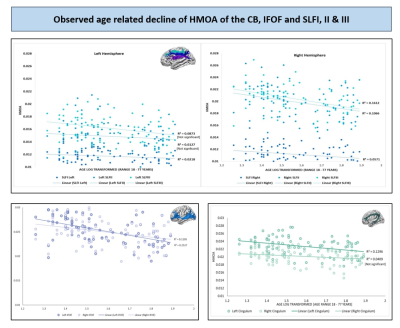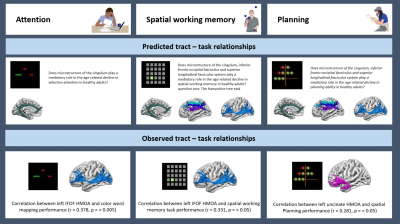Anoushka Leslie1, Ahmad Beyh1,2, Marco Catani3, Flavio Dell'Acqua3, Ceriesse Gunasinghe4, Henrietta Howells5, Richard Parker6, Andy Simmons1, Michel Thiebaut de Schotten7,8, Steve Williams1, and Mitul Mehta1
1Department of Neuroimaging, King's College London, London, United Kingdom, 2NatBrainLab, King's College London, London, United Kingdom, 3Natbrainlab, Department of Neuroimaging, King's College London, London, United Kingdom, 4Department of Psychological Medicine, King's College London, London, United Kingdom, 5Dipartimento di Biotecnologie Mediche e Medicina Traslazionale, Universita degli studi di Milano, Milano, Italy, 6IXICO plc, London, United Kingdom, 7Groupe d’Imagerie Neurofonctionnelle, Institut des Maladies Neurodégénératives-UMR 5293, Universite de Bordeaux, Bordeaux, France, 8Brain Connectivity and Behaviour Laboratory, BCBlab, Sorbonne Universities, Paris, France
Synopsis
This study aimed to expand our understanding of how changes to frontal white matter pathways might influence executive decline in healthy ageing. We selected three cognitive components of executive function, attention, spatial working memory and planning and predicted that changes to microstructure of the cingulum, IFOF and SLFI -III would play a mediatory role in age related cognitive decline of 86 healthy adults. Contrary to our predictions, no
mediation effects were found within the proposed tract - task groupings. Instead,
during exploratory analysis, HMOA of the left uncinate demonstrated a small to
medium indirect effect on age-related decline in planning performance.
Introduction
Performance on tasks of executive
function has been observed to decline with age. A better understanding of what
may influence these changes could contribute towards our understanding of what
promotes healthy ageing or direct research in patient cohorts. The role of cortical
and subcortical grey matter structures is recognised, but white matter
correlates are less well understood. This study aimed to examine the
relationship between changes in microstructure of frontal white matter pathways
and age-related decline of three key cognitive processes associated with
executive function (attention, working memory and planning). We predicted that
the cingulum (CB) would play a mediatory role in the age- related decline of
selective attention and that the CB, inferior fronto-occipital fasciculus
(IFOF) and superior longitudinal fasciculus (SLF) I, II and III would play
mediatory roles in age-related decline of spatial working memory and planning
performance (Fig. 3). We then conducted exploratory analysis including other
white matter pathways the frontal lobe (anterior segments of the corpus
callosum (CC), frontal aslant tract (FAT) and uncinate fasciculus (UF). Methods
104 healthy participants (18 – 79
years) took part in this cross-sectional observational study. Diffusion weighted
images were acquired through a spin-echo single-shot echo planar imaging (EPI)
sequence on a 3T General Electric Signa HDx Twin Speed system MRI scanner with
an 8-channel head coil (64 directions, b=3000 s/mm2, 2.4x2.4x2.4 mm3).
Corrections for head motion and eddy current distortion were applied using
exploreDTI. A HARDI based method using Spherical Deconvolution (SD) was applied
to reconstruct the white matter tracts (Dell’acqua et
al., 2010; Flavio Dell’Acqua et al, 2013).
Behavioural
measures were selected from the Cambridge Brain Sciences battery (Hampshire,
Highfield, Parkin, & Owen, 2012).
A subset of 18 participants was
used to establish reliability of manual and semi-automated tractography protocols
for measures of volume and Hindrance Modulated Orientation Anisotropy (HMOA), an
index of white matter diffusion properties, across all tracts in young and
older adults. Semi-automated tractography was conducted using MegaTrack, a
method that extracts volume and microstructure measures by mapping a single
manual dissection across a combined ‘Mega’ data set of multiple subjects. (Dell’Acqua
et al., 2015).
Data from a separate group of 86
participants were then analysed to test for age-related changes to tract
microstructure and task performance and correlations between microstructure and
task performance. We then performed mediation analysis to identify indirect effects
of tract microstructure on age-related cognitive decline.
Results
Overall volume and microstructure
measures from manual and semi-automated dissection protocols demonstrated good to
excellent reliability (whole group tract volume ICC: 0.66 – 0.92, whole group
HMOA ICC: 0.60 – 0.99) in both young and older adult age groups except for the
third segment (rostral body) of the CC, the right FAT and right
IFOF.
Significant age-related declines
were observed across all behavioural measures and all tracts except for the right CB, bilateral SLFI, and
left SLF II (Fig. 1 & 2).
Significant tract - task
correlations were identified across several different pathways and behavioural
measures. For example, the left IFOF HMOA was associated with behavioural
measures of attention and spatial working memory (Fig. 3). Contrary to our predictions, no mediation
effects were found within the proposed tract - task groupings shown in Fig. 3. Instead,
during exploratory analysis, HMOA of the left UF demonstrated a small to
medium indirect effect on age-related decline in planning performance in
healthy adults (Fig. 4). Discussion
The results from this study have
established that manual and semi-automated dissection protocols are reliable
for both young and older adults in a number of white matter pathways. This study also replicated age-related decline of
all behavioural measures and described for the first-time ageing trajectories
of the FAT and SLFI - III. The tracts observed to align to different facets of
executive function were not those that we predicted. For example, while there are reports regarding
the role of the SLF system in attention and motor processes (Howells et al.,
2018; Thiebaut de Schotten et al., 2011), this group of pathways did not align themselves
to the measures of attention used in this study. It could be speculated that
the SLF system operates as part of a wider network and as such does not present
as the primary tract system for these functions. Of note was the appearance of
the IFOF in association with two of the behavioural measures, which could be
indicative of the predominantly visual presentation of these tasks, emphasising
the important link between visual attention and executive function previously
postulated (Furey, et al, 2000). The observation of a mediatory role of the
left uncinate in age-related decline of planning provokes questions of whether this
tract’s role in inhibitory processing or verbal mediation may contribute
towards the completion of this planning task. Conclusion
These results provide promising
support for the use of semi-automated methods in diffusion tractography across
the adult lifespan. The tract – task associations provide new evidence
of both common and different white matter pathways supporting different facets
of executive function. Lastly, the role of the left uncinate may indicate a new
target for future research in identifying anatomical vulnerabilities associated
with either executive decline during normal aging or executive dysfunction in
patient groups. Acknowledgements
This abstract represents independent research part funded by the National Institute for Health Research (NIHR) Biomedical Research Centre at South London and Maudsley NHS Foundation Trust and King’s College London. The views expressed are those of the author(s) and not necessarily those of the NHS, the NIHR or the Department of Health and Social Care.References
REFERENCES:
Dell’Acqua,
F, Lacerda, F., Barret, R., D’Anna, L., Tsermentseli, S., Goldstein, L., &
Catani, M. (2015). A fast and effective strategy for group comparison and
supervised analysis of large-scale tractography datasets. 23rd Annual
Meeting and Exhibition. Presented at the International Society for Magnetic
Resonance in Medicine, Toronto, Ontario, Canada.
Dell’acqua,
F., Scifo, P., Rizzo, G., Catani, M., Simmons, A., Scotti, G., & Fazio, F.
(2010). A modified damped Richardson-Lucy algorithm to reduce isotropic
background effects in spherical deconvolution. NeuroImage, 49(2),
1446–1458. https://doi.org/10.1016/j.neuroimage.2009.09.033
Dell’Acqua,
Flavio, Simmons, A., Williams, S. C. R., & Catani, M. (2013). Can spherical
deconvolution provide more information than fiber orientations? Hindrance
modulated orientational anisotropy, a true-tract specific index to characterize
white matter diffusion. Human Brain Mapping, 34(10), 2464–2483.
https://doi.org/10.1002/hbm.22080
Furey,
M. L., Pietrini, P., & Haxby, J. V. (2000). Cholinergic Enhancement and
Increased Selectivity of Perceptual Processing During Working Memory. Science,
290(5500), 2315. https://doi.org/10.1126/science.290.5500.2315
Hampshire,
A., Highfield, R. R., Parkin, B. L., & Owen, A. M. (2012). Fractionating
human intelligence. Neuron, 76(6), 1225–1237.
https://doi.org/10.1016/j.neuron.2012.06.022
Howells,
H., Thiebaut de Schotten, M., Dell’Acqua, F., Beyh, A., Zappala, G., Leslie,
A., … Catani, M. (2018). Frontoparietal Tracts Linked to Lateralized Hand
Preference and Manual Specialization. Cerebral Cortex (New York, N.Y. :
1991), 28(7), 2482–2494. https://doi.org/10.1093/cercor/bhy040
Thiebaut
de Schotten, M., Dell’Acqua, F., Forkel, S. J., Simmons, A., Vergani, F.,
Murphy, D. G. M., & Catani, M. (2011). A lateralized brain network for
visuospatial attention. Nature Neuroscience, 14(10), 1245–1246.
https://doi.org/10.1038/nn.2905



